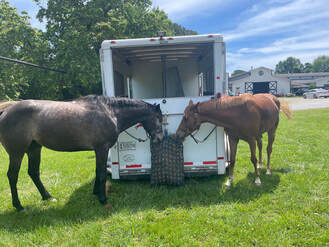 A lot of people have talked to me lately about buying or selling a horse. The Equestrian Voice podcast, Buying and Selling Horses under $40K, is a great resource, but there's added challenges for most people I know in this sport and this part of the country. For those who are searching in an even lower price range, or dealing with the complexities of living in an area (like NWA) that has a very low concentration of eventers and show jumpers, buying a new horse is quite an endeavor! I’ll write another post on selling, but let’s start with the fun part – purchasing! Whether it's your first horse or your 31st horse, if you want to buy a horse you have to start with a good amount of self-reflection. It’s necessary to be honest with yourself about your finances, goals, abilities, and the time/effort you are going to be able to devote to a new animal. No matter your price range, I strongly suggest working with a qualified trainer. The equine industry is all about relationships, and a good trainer may know about horses you wouldn’t be able to find on your own. They can also help you try horses, evaluate what’s suitable, interpret a pre-purchase exam, and navigate the purchase process. If you’re already taking lessons from someone (and want to continue that relationship), please do not go out and purchase a horse without their input! A lot of parents, especially those with a little horse savvy, don’t want to add the expense of a commission to their horse buying experience, but those dollars are going to be insignificant in comparison making a bad choice. Trainer involvement is not just about commission, although it’s likely any commission they receive will be well earned. There’s nothing worse than having a talented kid in your program who has lots of goals and dreams, then seeing that kid end up with a horse who is dangerous, green, lame, or otherwise unsuitable, when they could have a horse who keeps riding FUN for them and allows them to learn. If your trainer is traveling with you, especially long distance, keep in mind that they are likely taking day(s) off lessons and training income to help you find this horse and may even have to arrange for extra expenses in the form of horse or child-care at home. For dedicated travel, I usually request a modest day fee. For horses $10K and up, I will apply this day fee to the commission owed (usually 10% of sale price) once a horse is purchased. Before we even start thinking about looking at horses, I ask my clients to consider: 1) BUDGET – The horse’s purchase price is the CHEAPEST part of horse ownership. That being said, a $20,000 horse who has had good care for most of its life is often going to cost less to maintain than a $2,000 rescue. Make a spreadsheet and factor in board, shoeing, veterinary care, insurance, lessons, showing, new equipment, and then multiply all that times 1.5. Unless you’re a professional or a talented ADULT amateur who has brought along horses before, if you’re buying a horse who doesn’t have at least one year of experience doing the things at or above the level you want to do, factor in some training expense as well. After all this is calculated you can take an honest look at what may be available for your horse purchase price. 2) SELF-ASSESSMENT – Write down the following:
3) THE HORSE - THE FUN PART – Don’t even start talking about the horse until you’ve gone through the above budget and self-assessment. Everything in this section should be negotiable. Although a 17hh, 4 year old, dapple grey, WB gelding with four white socks may be the dream, that horse is useless if you can’t ride it. Be aware of your internal prejudices and focus on the behavioral characteristics that are going to help make this relationship most successful. THE RECKONING – It’s possible you may not be able to purchase a horse that meets all your wants and also is in your price range, in that situation you have two options – compromise or consider a lease. The easiest area to compromise in is age. Everyone wants a horse who is under age 10 or 12, but one who is 14 or 15 may have so much more experience, need less riding, not need any additional training, and be significantly more affordable, still while lasting another 10+ years. Have this conversation with your trainer and further develop a list of “must haves” and “would like to haves.” If you can’t afford the horse you need, then a paid lease is a great option! For growing kids or college students with uncertain futures, a lease may also be the most prudent option. So what happens next? If you’re lucky enough to live in a place that has horses who meet your needs within an hour or two, your trainer may be able to set up a few appointments. If you live in a more remote part of the country (like northwest Arkansas), it’s quite likely you may have to travel. Work with your trainer to set up a trip to a more concentrated location (such as Houston, Ocala, or Aiken) where you can look at multiple horses over the course of a day or two. Your trainer may post an ISO advertisement online or on various groups, do online searches of popular sites, and make phone calls to other people they know in the area. It may also be most effective to try horses while you’re already at a big show. I like to send a few ads or videos to my clients ahead of time to get their thoughts, but if I’m setting up a whole day of looking at horses, I likely won’t send them every advertisement ahead of time. Instead, we’ll just focus on how they feel riding and interacting with each horse! Before looking at any horse, I like to have the basics: name, age, breeding, show record, any major quirks or injuries or veterinary considerations written down. I keep this document on my phone and make notes once we are in-person. If possible, whenever I’m looking at horses with a client, I like to see the horse get caught from a paddock/field or in a stall, experience how they are for grooming and tacking, and then watch them go under saddle with the current owner or trainer riding first. From there I’ll put my client on the horse, and will likely also sit on the horse myself. For most clients if they have concerns getting on the horse after watching the current owner or trainer ride it, it’s not going to be a good fit. If at any point the ride is going very poorly, it’s time to get off. There’s NO shame in walking away at that point, you do not owe it to the seller to ride it out on every horse, especially if it’s not what you are looking for. Once I’m in front of the seller, I like to discuss things such as what the horse’s regular routine is, the horse’s personality, what tack they use and why, what the horse eats, what its turnout routine is, etc. If a seller thinks a horse has particular limitations or would prefer a particular job, I want to know WHY they think that. It’s important to make sure that the horse will be happy and comfortable in their new situation. While not every horse is currently in the optimal situation, a horse who is taken from a busy barn where he is turned out in a herd for 12 hours every night and worked every day, will likely have a drastic personality change (potentially for the worse) if he’s brought to a back yard barn, turned out with one other horse for a few hours a day, and ridden for 30 minutes 2-3 days a week. After trying 5-10 horse, ideally we’ve narrowed the search down to 1-2 good options. From there I usually get clients to pick their favorite and we schedule a vetting. This vetting needs to take into account the horse’s future use. If the horse is going to have a very low impact career and is coming from a person we trust and who knows the horse’s history or is willing to share current x-rays or medical records, anything more than a brief vetting may not be necessary. I could write an article on pre-purchase exams, but it’s important to remember that the vet’s job is to find issues and potential issues, and they will find something – the question is how much of an expense will it be later to fix or maintain, and will that something be likely to impede the horse from its intended future use. If the answer is clearly yes, it’s necessary to pass on that horse and move on to a second choice or start the search again. Vettings can also be used as a data point in price negotiation, however, in the current market most horses are selling for very close to asking price. If my client has gone through the whole process above and we’ve found a good one, I usually make a verbal offer to the seller – if it’s accepted, we draw up a contract and make arrangements for getting the horse home!
0 Comments
|
Details
Christy ZweigAdventures eventing as a semi-pro in the mid-south. Archives
April 2024
Categories |
Proudly powered by Weebly

 RSS Feed
RSS Feed